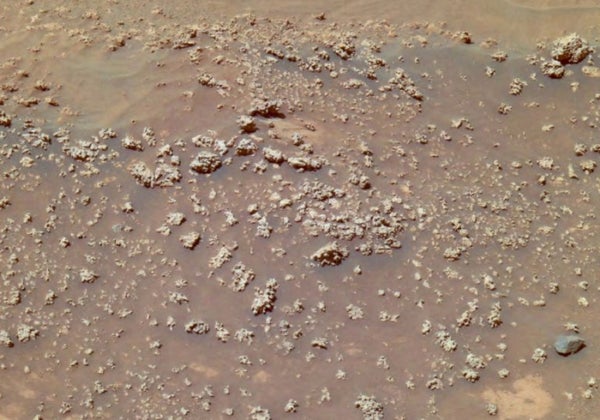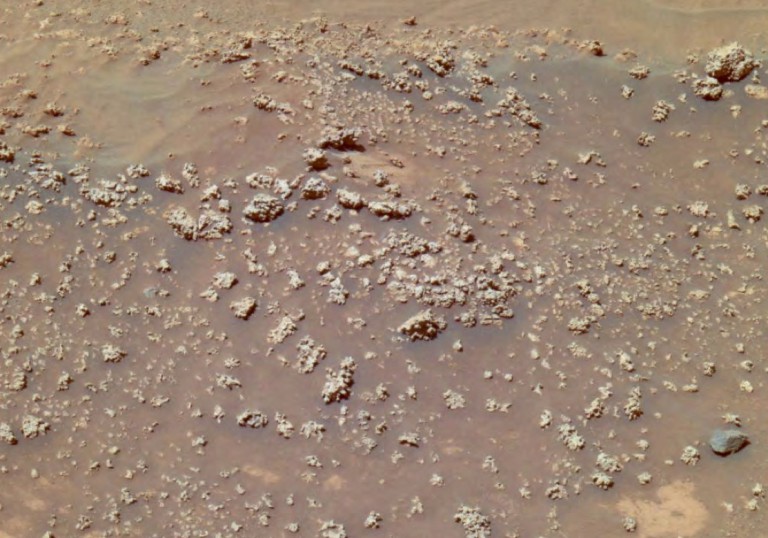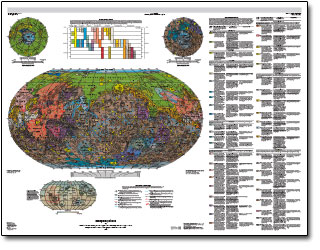This article was published in Scientific American’s former blog network and reflects the views of the author, not necessarily those of Scientific American
Every age has its reasons for being excited for being alive at that particular time. Ours includes geology on other planets. A lot of us were born and raised in a time when water on Mars was just a hope rather than a proven reality. Now we've got rovers there doing actual geology, and it is delicious, my darlings.
Let's go explore some of the most recent discoveries!
On supporting science journalism
If you're enjoying this article, consider supporting our award-winning journalism by subscribing. By purchasing a subscription you are helping to ensure the future of impactful stories about the discoveries and ideas shaping our world today.
Smithsonian: Mysterious Martian "Cauliflower" May Be the Latest Hint of Alien Life
In 2008, scientists announced that NASA’s Spirit rover had discovered deposits of a mineral called opaline silica inside Mars's Gusev crater. That on its own is not as noteworthy as the silica’s shape: Its outer layers are covered in tiny nodules that look like heads of cauliflower sprouting from the red dirt.
No one knows for sure how those shapes—affectionately called “micro-digitate silica protrusions”—formed. But based on recent discoveries in a Chilean desert, Steven Ruff and Jack Farmer, both of Arizona State University in Tempe, think the silica might have been sculpted by microbes. At a meeting of the American Geophysical Union in December, they made the case that these weird minerals might be our best targets for identifying evidence of past life on Mars.
If the logic holds, the silica cauliflower could go down in history as arguably the biggest discovery ever in astronomy. But biology is hard to prove, especially from millions of miles away, and Ruff and Farmer aren’t claiming victory yet. All they’re saying is that maybe these enigmatic growths are mineral greetings from ancient aliens, and someone should investigate.
This is an exquisitely cautious article, and I'd like to point out that, in addition to being fascinating, it's also an excellent example of good science reporting.
Geology Page: Curiosity rover finds evidence of Mars' primitive continental crust
"Along the rover's path we have seen some beautiful rocks with large, bright crystals, quite unexpected on Mars" said Roger Wiens of Los Alamos National Laboratory, lead scientist on the ChemCam instrument. "As a general rule, light-colored crystals are lower density, and these are abundant in igneous rocks that make up the Earth's continents."
Mars has been viewed as an almost entirely basaltic planet, with igneous rocks that are dark and relatively dense, similar to those forming the Earth's oceanic crust, Wiens noted. However, Gale crater, where the Curiosity rover landed, contains fragments of very ancient igneous rocks (around 4 billion years old) that are distinctly light in color, which were analyzed by the ChemCam instrument.
French and US scientists observed images and chemical results of 22 of these rock fragments. They determined that these pale rocks are rich in feldspar, possibly with some quartz, and they are unexpectedly similar to Earth's granitic continental crust. According to the paper's first author, Violaine Sautter, these primitive Martian crustal components bear a strong resemblance to a terrestrial rock type known to geologists as TTG (Tonalite-Trondhjemite-Granodiorite), rocks that predominated in the terrestrial continental crust in the Archean era (more than 2.5 billion years ago).
Continents on Mars!!! I really hope that when I am an old women, commercial flights to Mars are available and I'll get to go play with those delicious rocks.
Geology In: NASA Study Mineral Veins on Mars
Scientists now have a better understanding about a site with the most chemically diverse mineral veins NASA's Curiosity rover has examined on Mars, thanks in part to a valuable new resource scientists used in analyzing data from the rover.
Curiosity examined bright and dark mineral veins in March 2015 at a site called "Garden City," where some veins protrude as high as two finger widths above the eroding bedrock in which they formed.
The diverse composition of the crisscrossing veins points to multiple episodes of water moving through fractures in the bedrock when it was buried. During some wet periods, water carried different dissolved substances than during other wet periods. When conditions dried, fluids left clues behind that scientists are now analyzing for insights into how ancient environmental conditions changed over time.
Cross-cutting mineral veins on Mars. Delicious! Another thing on my list to go explore when we have regular Earth-Mars travel.
And, of course, if we're going to go exploring Mars, we should have a geologic map. Oh, look, the USGS has produced one!
You can read more about it here.
Isn't is awesome that we're living in an age where you don't have to choose between your passion for astronomy and geology? You can have both!
In our next edition of , we'll be exploring the bizarre geology of Pluto and Charon. Who would've thought that a little dwarf planet could contain such astonishing landforms?


